Doctors Help Newborn With Missing Foot
By Gorilla Doctors Staff on Monday, June 13th, 2011 in Uncategorized.This blog was written by Dr. Jan.
Umurimo of Umubano group in Volcanoes National Park was found to have given birth to a male on June 4 and the birth and infant were reported as normal that day. On June 5 trackers noted that the infant had a severe injury to his left foot. One June 6, Elisabeth Nyirakaragire, Volcanoes National Park’s Veterinary Warden, went to the group to assess the condition and reported that the left foot was missing and bone was exposed. An intervention was planned after conferring with Dr. Tony Mudakikwa of the Rwanda Development Board (RDB).
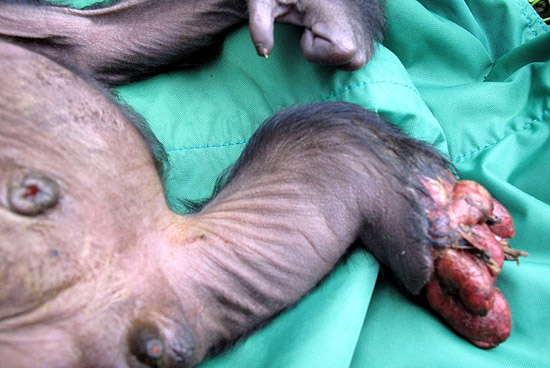 The wounded leg.Myself, Dr. Mike, Elizabeth and an RDB tracker team went to the group on June 7 prepared to intervene and amputate the injured leg. When we came to the group we found the 3-day-old infant to be strong and alert, seen nursing well. The left foot was missing, with the muscle bellies hanging from a small amount of skin remaining just below the knee. About 3 cm of shattered tibia and fibula were exposed.
The wounded leg.Myself, Dr. Mike, Elizabeth and an RDB tracker team went to the group on June 7 prepared to intervene and amputate the injured leg. When we came to the group we found the 3-day-old infant to be strong and alert, seen nursing well. The left foot was missing, with the muscle bellies hanging from a small amount of skin remaining just below the knee. About 3 cm of shattered tibia and fibula were exposed.
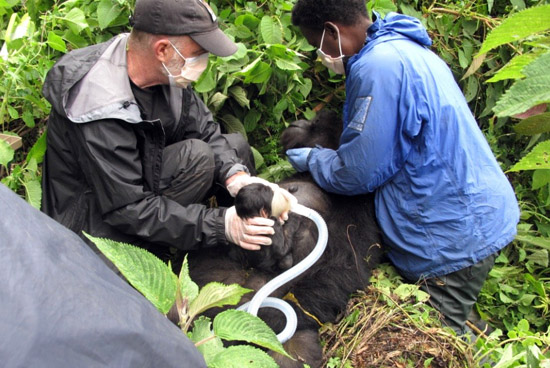 Mike administering isoflurane to the infant while Elisabeth monitors Umurimo.Umurimo was easily darted in the left shoulder at 10:12. She removed the dart, moved away and did not scream. The dart was recovered. She was anesthetized with 300 mg ketamine and 1 mg of dexmedetomadine. She was laying down at 10:21. Umurimo was stable throughout the procedure. Body temperature was 98.8 at 10:28, respirations remained stable at 22 breaths per minute, heart rate ranged between 52 and 55 beats per minute. O2 saturation remained at 100%. She was in good body condition, with no vaginal discharge related to recent birth. Milk was noted in both breasts. Swabs were taken of oral, nasal and rectal cavities. Blood was collected from the left femoral vein. She was monitored by Elisabeth throughout the infant’s procedure.
Mike administering isoflurane to the infant while Elisabeth monitors Umurimo.Umurimo was easily darted in the left shoulder at 10:12. She removed the dart, moved away and did not scream. The dart was recovered. She was anesthetized with 300 mg ketamine and 1 mg of dexmedetomadine. She was laying down at 10:21. Umurimo was stable throughout the procedure. Body temperature was 98.8 at 10:28, respirations remained stable at 22 breaths per minute, heart rate ranged between 52 and 55 beats per minute. O2 saturation remained at 100%. She was in good body condition, with no vaginal discharge related to recent birth. Milk was noted in both breasts. Swabs were taken of oral, nasal and rectal cavities. Blood was collected from the left femoral vein. She was monitored by Elisabeth throughout the infant’s procedure.
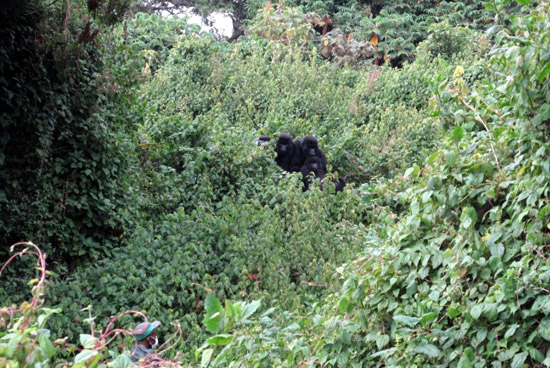 Other members of the Umubano family watch the intervention.The infant was injected with 10 mg ketamine and then masked with isoflurane at 3% and 1 ml/liter O2 flow rate. The flow rate was adjusted as his plane of anesthesia changed. He was injected at 10:21, mask administered at 10:25, he was fully anesthetized by 10:29. The infant was in very good body condition, estimated to weigh 5 kg. There were no wounds on the body other than those on the left leg.
Other members of the Umubano family watch the intervention.The infant was injected with 10 mg ketamine and then masked with isoflurane at 3% and 1 ml/liter O2 flow rate. The flow rate was adjusted as his plane of anesthesia changed. He was injected at 10:21, mask administered at 10:25, he was fully anesthetized by 10:29. The infant was in very good body condition, estimated to weigh 5 kg. There were no wounds on the body other than those on the left leg.
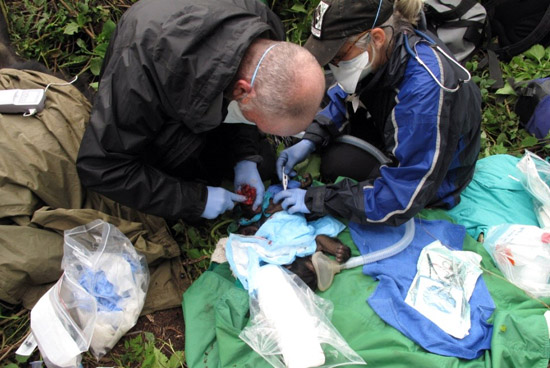 Field surgery.On palpation the distal left femur was found to be fractured, likely multiple fractures and the left thigh was swollen. The tibia and fibula were exposed for about 3-4 cm distal to the knee and the bone was discolored, shattered and sharp. All muscle bellies were exposed. There were signs of healing as the muscle bellies had considerable fibrin holding them together. There was no bad smell or purulent discharge noted. At 10:34 the body temperature was 94.21, respirations 66 breaths/minute, heart rate 156 beats per minute. Mucous membranes were moist and pale pink, capillary refill time less than 2 seconds. The heart rhythm and sounds were normal, lungs were clear and moving air on both sides. Abdomen palpated normally.
Field surgery.On palpation the distal left femur was found to be fractured, likely multiple fractures and the left thigh was swollen. The tibia and fibula were exposed for about 3-4 cm distal to the knee and the bone was discolored, shattered and sharp. All muscle bellies were exposed. There were signs of healing as the muscle bellies had considerable fibrin holding them together. There was no bad smell or purulent discharge noted. At 10:34 the body temperature was 94.21, respirations 66 breaths/minute, heart rate 156 beats per minute. Mucous membranes were moist and pale pink, capillary refill time less than 2 seconds. The heart rhythm and sounds were normal, lungs were clear and moving air on both sides. Abdomen palpated normally.
The wound was cleaned vigorously with dilute nolvasan. 250 mg of Ceftriaxone reconstituted with lidocaine was injected just proximal to the injury. The muscle bellies and exposed bone were surgically amputated and the skin undermined. The stump was flushed liberally with 500 ml sterile NaCl laced with 250 mg of ceftriaxone, and closed in 2 layers. Fascia was closed with a ford interlocking pattern using O maxon, and skin closed with mattress pattern using O maxon. The infant was treated with 40 mg baytril SQ. The infant’s body temperature declined steadily throughout the procedure. The plan had been to administer SQ fluids to the infant, but at 11:00 his body temperature was down to 92.1. As soon as the wound was closed he was removed from isoflurane (11:15) and placed back onto his mother’s belly.
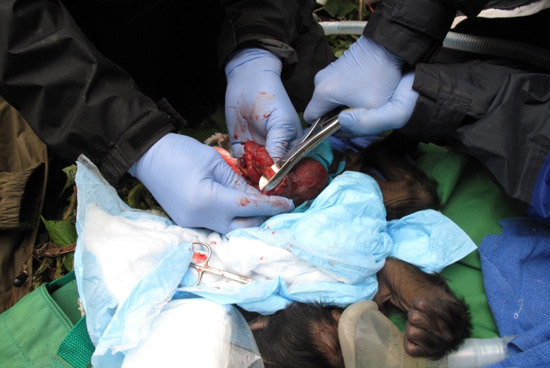 Sewing up the wound.Umurimo immediately sat up, clutched her infant and began to try to walk away. She was followed, and 2cc atipamazole was administered. She sat for some time about 10 meters from the team. The infant was whimpering, and screamed several times. Umurimo’s oldest son Bunyenyeri, a young silverback in the group, responded to the infant vocalizations and moved toward the team, but very calmly passed us to go to his mother and young brother. He sat with them a bit, then they moved on.
Sewing up the wound.Umurimo immediately sat up, clutched her infant and began to try to walk away. She was followed, and 2cc atipamazole was administered. She sat for some time about 10 meters from the team. The infant was whimpering, and screamed several times. Umurimo’s oldest son Bunyenyeri, a young silverback in the group, responded to the infant vocalizations and moved toward the team, but very calmly passed us to go to his mother and young brother. He sat with them a bit, then they moved on.
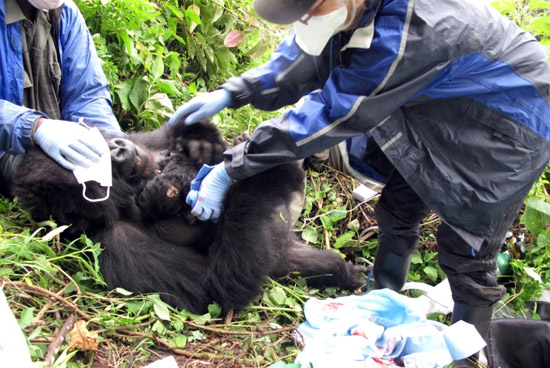 Returning the infant to Umurimo.Trackers reported that Umurimo was eating and behaving normally in the group later in the day. The infant was seen nursing normally the next day by Elisabeth. She also observed him on June 10, and he was bright, alert and responsive. Nursing well with no discharge from the closed wound.
Returning the infant to Umurimo.Trackers reported that Umurimo was eating and behaving normally in the group later in the day. The infant was seen nursing normally the next day by Elisabeth. She also observed him on June 10, and he was bright, alert and responsive. Nursing well with no discharge from the closed wound.
The trackers will watch mother and son closely for the next 5 to 7 days for signs of infection or other deterioration. Trackers to report to Elisabeth daily.
We know of other gorillas who have grown into adulthood successfully despite having missing limbs. Fingers crossed that this little infant will be another success!
Please consider supporting the Gorilla Doctors by making a secure online donation. Every dollar you give goes to directly supporting our gorilla health programs and One Health initiative. Thank you for your generosity.
For the most up-to-date information about the Gorilla Doctors, “like” our Facebook page. You’ll find gorilla health reports, news items, photos, videos, and links to related content.


 Donate
Donate